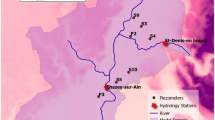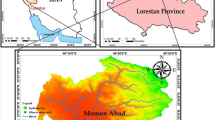Abstract
In this article, the GMS finite difference simulation of “No Bandegan (NB) Plain” aquifer has been studied. The groundwater flow path and intensity in the plain have been simulated by modeling input to and output from the aquifer. Spatial distributions of four major pollutants have been determined by groundwater sampling at different piezometers and wells throughout the plain. Discharge withdrawal from wells, water quality parameters, and water table drop were simulated repeatedly pursuant to the constraints defined by an (artificial neural network) ANN. The validated ANN was then linked to a multi-objective optimization model to find a Pareto optimal front among the three objectives of enhancing water quality, increasing equity in withdrawal allocation, and reducing water table drawdown. Results were optimized in an agent-based (A-B) approach seeking quantitative and qualitative management of water allocation in the plain. The optimization process caused a reduction in annual water table decline by up to 68% compared to observed drawdowns in the plain. Similarly, the proposed method improved groundwater quality as indexed by pH, TH, TDS, and EC parameters by 8.8, 27.7, 28.4, 25.5%, relative to their observed values, respectively.











Similar content being viewed by others
References
Akhbari M, Grigg NS (2013) A framework for an agent-based model to manage water resources conflicts. Water Resour Manag 27(11):4039–4052
Akhbari M, Grigg NS (2014) Water management trade-offs between agriculture and the environment: a multiobjective approach and application. J Irrig Drain Eng. https://doi.org/10.1061/(ASCE)IR.1943-4774.0000737
Akhbari M, Grigg NS (2015) Managing water resources conflicts: modelling behavior in a decision tool. Water Resour Manag 29(14):5201–5216
Al-Jawad JY, Al-Jawad SB, Kalin RM (2019) Decision-making challenges of sustainable groundwater strategy under multi-event pressure in arid environments: the diyala river basin in Iraq. Water 11(10):1–19
Banta ER, Hill MC, Poeter E, Doherty JE, Babendreier J (2008) Building model analysis applications with the joint universal parameter identification and evaluation of reliability (JUPITER) API. Comput Geosci 34(4):310–319
Batelaan O, Peeters LJ (2020) Review of hydrogeology: groundwater science and engineering by Alain Dassargues. J Hydrol Eng ASCE. https://doi.org/10.1061/(ASCE)HE.1943-5584.0001883
Berger T, Birner R, Mccarthy N, DíAz J, Wittmer H (2007) Capturing the complexity of water uses and water users within a multi-agent framework. Water Resour Manage 21(1):129–148
Berglund EZ (2015) Using agent-based modeling for water resources planning and management. J Water Resour Plan Manag. https://doi.org/10.1061/(ASCE)WR.1943-5452.0000544
De Almeida SJ, Ferreira RPM, Eiras ÁE, Obermayr RP, Geier M (2010) Multi-agent modeling and simulation of an Aedes aegypti mosquito population. Environ Model Softw 25(12):1490–1507
Dietz T, Ostrom E, Stern PC (2003) The struggle to govern the commons. Science 302(5652):1907–1912
Elsawah S, Guillaume JH, Filatova T, Rook J, Jakeman AJ (2015) A methodology for eliciting, representing, and analysing stakeholder knowledge for decision making on complex socio-ecological systems: from cognitive maps to agent-based models. J Environ Manag 15:1500–1516
Evans R, Turnbull S, Richards D (1995) The use of the DoD groundwater modeling system (GMS) to model the hydrodynamics of central O’ahu, Hawai’i. In: Hermann R, Back W, Sidle, RC, Johnson AI (eds) Water resources and environmental hazards: emphasis on hydrologic and cultural insight in the Pacific Rim, Proceedings of the American Water Resources Association annual summer symposium, Honolulu, Hawaii, pp 257-266
Farhadi S, Nikoo MR, Rakhshandehroo GR, Akhbari M, Alizadeh MR (2016) An agent-based-nash modeling framework for sustainable groundwater management: a case study. Agric Water Manag 177:348–358
Ganjali N, Guney C (2017) Gis and game theory for water resource management. ISPRS annals of photogrammetry. Remote Sens Spat Info Sci 4:215–220
Graillot D, Gaur S, Chahar BR, Mimoun D (2013) Analytic element and particle swarm based simulation-optimization model for groundwater Management. In: 6th international conference on the Analytic Element Method, Golden, MS, United States
Graillot D, Paran F, Bornette G, Marmonier P, Piscart C, Cadilhac L (2014) Coupling groundwater modeling and biological indicators for identifying river/aquifer exchanges. Springerplus 3:68. https://doi.org/10.1186/2193-1801-3-68
Han Q, Tan G, Fu X, Mei Y, Yang Z (2018) Water resource optimal allocation based on multi-agent game theory of HanJiang river basin. Water 10(9):1184. https://doi.org/10.3390/w10091184
Jafari A, Mahdavi R, Malekian A, Gholami H, Habibzadeh A (2019) Preparation of the quaternary deposits and bed rock jam aquifer. Bushehr province conceptual stratigraphy modeling using GMS model. Iran J Watershed Manag Sci Eng 12:22–29
Kalhor K, Ghasemizadeh R, Rajic L, Alshawabkeh A (2019) Assessment of groundwater quality and remediation in karst aquifers: a review. Groundw Sustain Dev 8:104–121
Kent G (2014) Modeling and analysis of management for an agro-ecosystem using an agent-based model interface for the soil and water assessment tool (SWAT). MS Thesis, Department of Agricultural and Biological Engineering, University of Illinois at Urbana-Champaign, IL, USA
Kovarik K (2010) Numerical simulation of groundwater flow and pollution transport using the dual reciprocity and RBF method. Commun Sci Lett Univ Zilina 12:5–10
Martínez-Santos P, Llamas MR, Martínez-Alfaro PE (2008) Vulnerability assessment of groundwater resources: a modelling-based approach to the Mancha Occidental aquifer. Spain Environ Model Softw 23(9):1145–1162
Mazzega P, Therond O, Debril T, March H, Sibertin-Blanc C, Lardy R, Sant’Ana D (2014) Critical multi-level governance issues of integrated modelling: An example of low-water management in the Adour-Garonne basin (France). J Hydrol 519:2515–2526
Mulligan KB, Brown C, Yang YCE (2014) Ahlfeld D.P., assessing groundwater policy with coupled economic-groundwater hydrologic modeling. Water Resour Res 50(3):2257–2275
Ohab-Yazdi SA, Ahmadi A (2018) Using the agent-based model to simulate and evaluate the interaction effects of agent behaviors on groundwater resources, a case study of a sub-basin in the Zayandehroud River basin. Simul Model Pract Theory 87:274–292
Pérez-Blanco C, Standardi G (2019) Farm waters run deep: a coupled positive multi-attribute utility programming and computable general equilibrium model to assess the economy-wide impacts of water buyback. Agric Water Manag 213:336–351
Peurifoy J, Shen Y, Jing L, Yang Y, Cano-Renteria F, DeLacy BG, Joannopoulos JD, Tegmark M, Soljačić M (2018) Nanophotonic particle simulation and inverse design using artificial neural networks. Sci Adv 4(6):eaar4206. https://doi.org/10.1126/sciadv.aar4206
QuanLi X, Kun Y, GuiLin W, YuLian Y (2015) Agent-based modeling and simulations of land-use and land-cover change according to ant colony optimization: a case study of the Erhai Lake Basin China. Nat Hazards 75(1):95–118
Rajabi MM, Ataie-Ashtiani B, Simmons CT (2018) Model-data interaction in groundwater studies: review of methods, applications and future directions. J Hydrol 567:457–477
Reeves HW, Zellner ML (2010) Linking MODFLOW with an agent-based land-use model to support decision making. Groundwater 48(5):649–660
Valbuena D, Verburg PH, Veldkamp A, Bregt Ligtenberg AKA (2010) A effects of farmers’ decisions on the landscape structure of a Dutch rural region: an agent-based approach. Landsc Urban Plan 97(2):98–110
Author information
Authors and Affiliations
Corresponding author
Rights and permissions
About this article
Cite this article
Elhamian, S.A.B., Rakhshandehroo, G. & Javid, A.H. Quantitative and Qualitative Optimization of Water Allocation in No Bandegan Aquifer using an Agent-based Approach. Iran J Sci Technol Trans Civ Eng 46, 523–534 (2022). https://doi.org/10.1007/s40996-021-00656-1
Received:
Accepted:
Published:
Issue Date:
DOI: https://doi.org/10.1007/s40996-021-00656-1




